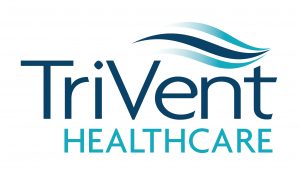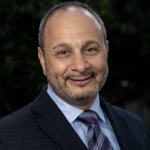


 After several years as an executive at two Fortune 100 companies, Sam Nimah, MBA, CPA became the CEO and owner of TriVent Healthcare in March 2014.
After several years as an executive at two Fortune 100 companies, Sam Nimah, MBA, CPA became the CEO and owner of TriVent Healthcare in March 2014.
While healthcare has always been one of Nimah’s passions, he also fell in love with the positive clinical impact the company has on its patients. Currently, he serves on the Board of Advisors for The Center for Supply Chain Management at The University of Florida and is a member of the Young Presidents Organization of Palm Beach.
Nimah earned his Bachelor of Accounting from the University of Florida and his Master of Business Administration from Florida Atlantic University.
Connect with Sam on LinkedIn and TriVent Healthcare on Facebook.
What You’ll Learn In This Episode
TriVent Healthcare
- Difference between a Trivent Healthcare unit in a hospital compared to an ICU in a hospital
- Help with partner hospitals during the COVID-19 pandemic
- The importance for hospitals to have a dedicated ventilator care unit and staff
This transcript is machine transcribed by Sonix
TRANSCRIPT
Intro: [00:00:01] Broadcasting live from the Business RadioX studios in South Florida. It’s time for South Florida Business Radio now. Here’s your host.
Lee Kantor: [00:00:14] Lee Kantor here another episode of South Florida Business Radio. And this is going to be a good one. But before we get started, it’s important to recognize our sponsor, Diaz Trade Law, your customs expert today on South Florida Business Radio, we have Sam Nimah with TriVent Healthcare. Welcome, Sam.
Sam Nimah: [00:00:33] Hey, thanks, Lee. How are you this afternoon?
Lee Kantor: [00:00:35] I am doing well. I’m so excited to learn what you have to tell us about private health care. How are you serving, folks?
Sam Nimah: [00:00:41] Well, we are a a unique one of a kind company. We operate inside of hospitals. We work and partner with hospitals to care for their ventilated patients who’ve had a tracheostomy. So they are typically the most complex patients in the hospital. And we we help them liberate from the ventilator.
Lee Kantor: [00:01:04] So how did this idea come about?
Sam Nimah: [00:01:06] Well, it was started about 30 years ago by a respiratory therapist. They simply needed they needed a better solution for this patient population. These patients are typically in the hospital for a very long time. They can sit in an ICU for a very long time, which is very expensive real estate within a hospital. And they are they have been a challenge for the entire industry to get off the ventilator and permanently and and moved in through the continuum of care. So it was founded 32 years ago.
Lee Kantor: [00:01:41] And then so so you’re becoming your organization is a specialist in this niche?
Sam Nimah: [00:01:48] Yes. In fact, we’re the only specialists in this niche.
Lee Kantor: [00:01:51] Now, why is it something that the hospital staff can’t handle?
Sam Nimah: [00:01:56] So so these patients typically start in an ICU, and ICU stands for intensive care unit, as we all know. And the idea in an intensive care unit is to help the patient survive. It’s not about rehabilitation. It’s simply about survival and stabilization. So patients don’t typically rehabilitate in the ICU. And so we are a stepdown level of care from ICU. And we have a model of care that allows us to really laser focus on just this patient population. Whereas an ICU, it could be a neuro ICU or a medical ICU or post surgical ICU. But a tragic event patient requires a very different approach. In any one of those ICU, you may have you may have one tragic event patient. But in our stepdown unit, we take all of the patients and we it’s a laser focus on that patient population.
Lee Kantor: [00:02:59] So then you’re taking the patient out of the hospital into your facility?
Sam Nimah: [00:03:04] No, we work with the hospital in the hospital. So we operate inside the hospital. We have a unit within the hospital, but we operate inside the hospital.
Lee Kantor: [00:03:13] Now, do you work in hospitals all over South Florida or just in a handful of hospitals?
Sam Nimah: [00:03:19] So the closest unit we have to south Florida is Tampa General Hospital. We are not currently in South Florida.
Lee Kantor: [00:03:27] So you’re based in south Florida, but your your operations, you’re working around the country?
Sam Nimah: [00:03:32] Yes, it is our corporate home.
Lee Kantor: [00:03:35] And then so why are some hospitals open to this and others hesitant?
Sam Nimah: [00:03:42] The model of care is very uniquely. Many hospitals are not familiar with it. There is a model of care called a long term acute care hospital, which is actually a standalone facility. Hospitals can and can discharge those patients to those hospitals. The results have not been fantastic in those hospitals for this particular patient population. They have a they have a role to play in our industry, but tragic event patients. They’ve just they’ve been a problem in the ICU. They’ve been a problem in health tax. I have not seen anybody who provides the outcomes for patients that we do.
Lee Kantor: [00:04:29] Now is what makes you different. Is it your personality or training? Do you have technology that that makes you different?
Sam Nimah: [00:04:38] You know, people ask us our secret sauce all the time. What I tell them is we have so many ingredients to the secret sauce that it’s really difficult to pinpoint any one. Yes. Do we have personnel that is allowed to? This is a key point. We allow our personnel to practice through the entire scope of their professional training. If you ask many respiratory therapists. What they get to do. They have so many patients to see on a daily basis and they have to travel throughout the hospital typically to see them. So there’s a lot of windshield time. So by the time they get to the patient, they don’t get to, again, practice through the entire scope of their professional training. On our unit, we don’t have a respiratory therapist coming from all over the hospital. They are dedicated to our unit. And by the way, I’m talking about respiratory therapy, but it’s really all of the disciplines. So we get to work together as a small group. A small team. And we get to really, again, practice the entire scope of our professional training. That’s such an important piece. And and it’s it’s often overlooked when you have people that don’t get to practice through the entire scope. They don’t get the level of satisfaction in their job that they do on our unit. So the satisfying is on our unit, not pay, not the hours are long, the patients are hard, but it’s really the ability to to work as a team, as a team member and through the entire scope of their professional training.
Lee Kantor: [00:06:23] Now, why do you think it’s important for hospitals to invest in something like this and have a dedicated ventilator care unit and staff there in their facility?
Sam Nimah: [00:06:34] Well, everywhere I go in the country, I look at the statistics for these patients. And anywhere I go, the statistics are bad. There isn’t a single place in the country that that handles this patient population as well as the results of providing on a daily basis. Now, we’re not for everybody. If you have a very, very young, healthy population, I’ll give you an example. We were asked to to quote some business in Utah, and frankly, there weren’t enough of this patient population to make one of our units viable. But then we looked in in markets where there’s either a large population density or a large enough population density of of elderly, and there’s just so many of these patients. So it’s not for everybody. We would never go to probably North Dakota because there just isn’t enough volume there for us to make sense. But in the markets where we provide care, we are doing so in a manner that provides better care for the patient. It saves the hospital money and it improves some really key statistics for them, and that’s length of stay and quality metrics, which are huge in hospital reimbursement.
Lee Kantor: [00:07:56] So what are some of those clues that a hospital that isn’t partnering with you? What are some of the symptoms they’re having where try them may be able to be a good partner and a good solution for them?
Sam Nimah: [00:08:08] Sure. Very, very simple. The length of stay for this patient population, they’ll they’ll see it climbing and high. The readmission rate, meaning the rate at which they discharge a patient and they come right back to the hospital for the same disease. That is another indicator. And then lastly, their internal ventilator liberation percentage. The national average for ventilator liberation is about 60%. We consistently have been providing ventilator liberation at 86%. In fact, the next level of success, if you will, after you wean the patient or liberate the patient from the ventilator, is to decontaminate them, remove that cannula from their throat. And we’re doing that at a rate that exceeds 60%. So we’re decontaminating patients at a rate in excess of the national average for ventilator liberation. So anywhere where there’s population density, we see that the length of stay for this patient population is super high. And anywhere that happens, we can be of assistance.
Lee Kantor: [00:09:17] Now, how what is like kind of the onboarding and the transition to partner with you look like? Because a lot of folks, you know, this type of change management might be a bridge too far for some people. Can you talk about what it feels like to go, you know, a before and after when you’re working with Prevent?
Sam Nimah: [00:09:34] Sure. I mean, we’re fairly turnkey. We provide most of the resources for our own unit. We one key thing is we do not provide the physicians. We allow the physicians in the hospital to to to do what they do best. So we partner with the physicians in the hospital. We provide all of the other staffing and incremental care in the unit. And it’s again, it takes about 4 to 6 months to to stand one of our units up. But it’s fairly turnkey. We do a lot of the heavy lifting.
Lee Kantor: [00:10:10] Is there any story you can share about kind of a problem that one of the hospitals had? Then you came in and you helped them get maybe to a better place?
Sam Nimah: [00:10:20] Yeah, You know, so. So I could very easily share one story. There was a patient. She was a bilateral lung transplant patient, and she had been discharged to El TAC two times and readmitted both times to the hospital. She had failed to wean from the ventilator a number of times, but all in Lea. She had been hospitalized for over three years. I want to I want to let that sit three years in my hospital. So we had gotten we’d gotten a shot at her. They sent her over to us and frankly, we were able to wean her off the ventilator in 32 days. After three years of being hospitalized. She got off the ventilator, spent a couple of weeks in inpatient rehab after that, and then she got to go home. Now, I love that story because it shows the the the high end of the spectrum of what we can do. But the reality is there’s not a lot of bilateral lung transplant patients out there. What we love is the little everyday stories we’ve got. We’ve got dozens of them. But we had a we had a name for a hot rod motorcycle driver. His crew chief came down with COVID. And then ultimately had to be tracked on the ventilator. And we helped save his life. We got to participate in that. That that team went on to build one of the third fastest motorcycle engine in history and actually gave us a duplicate of one of their trophies after they want to race. And they brought it back to our unit. And that was really cool. But the other piece is I like to tell the stories. Like, for example, we mentioned Tampa General, their CEO in a recent article written he expressed that we saved them in fiscal 21. We saved them $2.3 million. Now we know hospitals are really taking it on the chin right now. Financials are really, really at risk. So when we can help save a hospital $2.3 million, that’s meaningful. And those those are all those are all stories to tell.
Lee Kantor: [00:12:42] So now you mentioned COVID. Was it were the hospitals that had you there, was that a big help for them to kind of go through that that period of crisis?
Sam Nimah: [00:12:54] Yeah, Yeah, we are. We’re proud to be part of the COVID response in our hospitals. We were able to take post COVID patients and wean them off the ventilator. I told you that our our our liberation percentage is about 86%. Frankly, with COVID patients, it was over 90%. We had great success getting COVID patients off the ventilator. And that’s when, by the way, everybody was telling you that if you went on the ventilator with COVID, it was going to be a bad outcome. We had amazing success with that patient population. At one point during one of the peaks, we were actually called on by one of our hospitals and they said, Look, we don’t need a ventilator weaning unit right now. What we really need is a COVID unit. And so we told our team, Hey, we’re going to transition for a period of time. And for six weeks we became an extension of a COVID unit for the hospital. And then when the six weeks were up and the latest surge died down, we went back to doing what we do. But during COVID, we all needed to be good partners. And so we just we did what we needed to do.
Lee Kantor: [00:14:00] So what do you need more of? How can we help you? Look, do you need more hospitals? You need more folks to work there? How can we help you?
Sam Nimah: [00:14:10] Well, I’ll tell you, we have there’s there’s plenty of patients both in South Florida and throughout the country that need this care. And they’re not getting it. They’re not getting it in South Florida, when we would love to be able to to provide it and where, frankly, where our corporate home is. Right. I live in South Florida, and we’re looking forward to partnering with some hospitals in this market and others.
Lee Kantor: [00:14:33] So who in the hospital do you need to talk to?
Sam Nimah: [00:14:36] Oh, goodness. You know, any anybody in the C-suite, frankly, whether it’s the CEO, the chief medical officer, is typically a huge fan of what we do because they see the quality metrics and the outcomes. The chief financial officer can identify what the dollars that we’re going to save them or make them. So really anybody in the C-suite is an appropriate in for us.
Lee Kantor: [00:15:01] And then you said it’s in hospitals in areas where there’s an elderly population. That’s kind of the sweet spot for you.
Sam Nimah: [00:15:09] Either either a large elderly population or a or a super large population density. I’ll give you an example. In New York City, for example, there are over 8000 patients in New York City alone every year. That’s just a huge number.
Lee Kantor: [00:15:29] So if somebody wants to learn more, have a more substantive conversation with you or somebody on the team, what’s the website?
Sam Nimah: [00:15:35] Yeah, it is to prevent H I’m sorry, to prevent health care. Try vents, not try. Don’t try vent health care dot com.
Lee Kantor: [00:15:45] That’s try V.A. health care.com.
Sam Nimah: [00:15:50] Yes, sir.
Lee Kantor: [00:15:50] Well, Sam, thank you so much for sharing your story today. You’re doing such important work and we appreciate you.
Sam Nimah: [00:15:56] Ali, I appreciate the opportunity to chat with you.
Lee Kantor: [00:15:59] All right. This is Lee Kantor. We’ll see you all next time on South Florida Business Radio.














